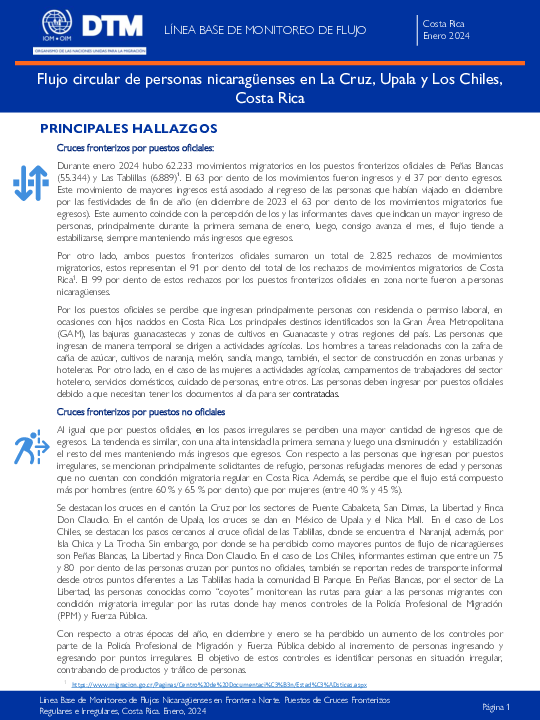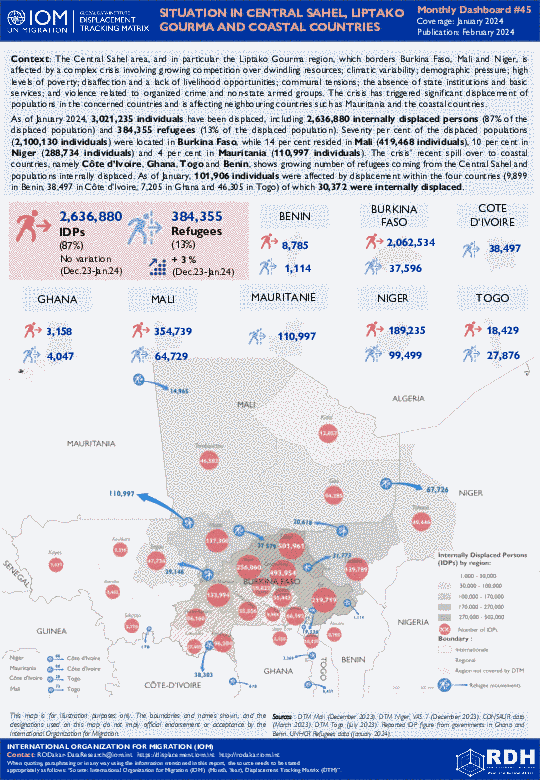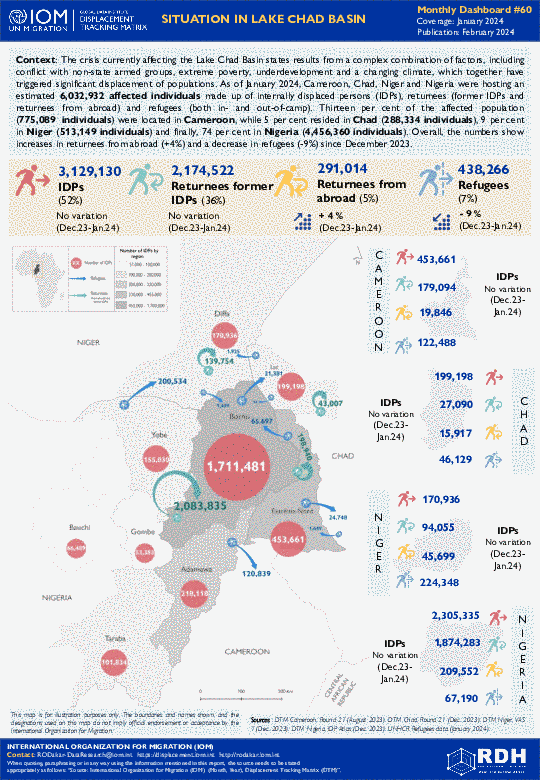-
Countries
-
Data and Analysis
-
Special Focus
-
Crisis Responses
Baseline Assessment
Contact
DTM Mozambique, DTMMozambique@iom.int
Location
Mozambique
Activity
- Mobility Tracking
- Site Assessment
- Baseline Assessment
Period Covered
Dec 05 2023 -Dec 29 2023
This Multi-Sectorial Location Assessment Round 13 assessment aims to enhance understanding of the extent of internal displacements and the needs of the displaced population affected by conflict and natural disaster in eight provinces of Mozambique. In total, 317,224 internally displaced persons (IDPs) or 81,383 households were mapped living in sites assessed during this MSLA Round 13.
Population Groups
IDPs
Survey Methodology
Unit of Analysis Or Observation
Admin Area 2
Admin Area 3
Admin Area 4
Site or Location
Type of Survey or Assessment
Key Informant
Keywords
Geographical Scope Partial Coverage
Administrative boundaries with available data
The current dataset covers the following administrative boundaries
Contact
DTM Mozambique, DTMMozambique@iom.int
Location
Mozambique
Activity
- Mobility Tracking
- Baseline Assessment
Period Covered
Dec 05 2023 -Dec 29 2023
This dataset is the 20th round of Mobility Tracking Assessments conducted across Mozambique through key-informant assessments and group interviews at the location level in December 2023. Mobility Tracking assessments estimate the presence of internally displaced persons (IDPs) and returnees across Mozambique. IOM DTM mapped a total of 709,529 IDPs and 632,408 returnees in round 20.
A more detailed version of this dataset is available, to get access kindly click on the 'Request Access' button
Population Groups
IDPs
Returnee (Previously Internally Displaced)
Survey Methodology
Unit of Analysis Or Observation
Admin Area 2
Admin Area 3
Admin Area 4
Site or Location
Type of Survey or Assessment
Key Informant
Keywords
Geographical Scope Partial Coverage
Administrative boundaries with available data
The current dataset covers the following administrative boundaries
Contact
DTM Sudan, DTMSudan@iom.int
Location
Sudan
Activity
- Mobility Tracking
- Baseline Assessment
Period Covered
Apr 15 2021 -Feb 07 2024
- DTM Sudan estimates that 6,217,222 individuals (1,238,945 households) were recently internally displaced.
- The IDP caseload was observed in 6,709 locations across all of Sudan’s 18 states.
- The highest proportions of IDPs were observed across South Darfur (12%), River Nile (11%), East Darfur (11%), White Nile (8%), North Darfur (7%), Sennar (7%), Central Darfur (7%), Northern (6%), Gedaref (6%), and Aj Jazirah (6%).
- Field teams reported that the IDPs observed were originally displaced from twelve states. The majority (3,530,771 IDPs, 57%) were reportedly displaced from Khartoum state; followed by South Darfur (15%), North Darfur (8%), Aj Jazirah (7%), Central Darfur (4%), West Darfur (4%), East Darfur (1%), South Kordofan (1%), West Kordofan (1%), North Kordofan (1%), Sennar (<1%), and White Nile (<1%).
- IOM-DTM also reported that an estimated 1,803,213 mixed cross-border movements were made into neighbouring countries.
- This product provides brief insights into those displaced in Sudan post-15 April 2023. For more granular information on the IDP caseload and the displacement context, please see IOM-DTM's Monthly Displacement Overview (05).
A more detailed version of this dataset is available, to get access kindly click on the 'Request Access' button
Population Groups
IDPs
Survey Methodology
Unit of Analysis Or Observation
Site or Location
Type of Survey or Assessment
Key Informant
Keywords
Geographical Scope Partial Coverage
Administrative boundaries with available data
The current dataset covers the following administrative boundaries

Contact
DTMUkraine@iom.int
Language
English
Location
Ukraine
Period Covered
Jan 01 2024
Jan 31 2024
Activity
- Baseline Assessment
The Registered IDP Area Baseline Assessment provides granular data on the number and geographic location of officially registered internally displaced people (IDPs). This report assesses registered IDP presence at the raion level, also mapping the recorded change since the previous round. Round 32 presents the data of the registered IDP population disaggregated by sex, age and state-recognised disability status.
The data collected for the Area Baseline Assessment Round 32 reflects the up-to-date local administrative register of the IDP population as of 31 January 2024, equivalent to a total of 3,509,147 registered IDPs. Registered IDP figures were collected for 1,098 hromadas (83% of all hromadas covered in Ukrainian government-controlled areas), across 108 raions and 23 oblasts. Data disaggregated by age, sex and disability status were provided for around 83 per cent of the administrative units covered.

Contact
DTMCostaRica@iom.int
Language
English
Location
Costa Rica
Period Covered
Jan 01 2024
Jan 31 2024
Activity
- Flow Monitoring
- Baseline Assessment
La Organización Internacional para las Migraciones (OIM), como agencia de las Naciones Unidas en materia de migración en Costa Rica, implementó, desde 2021, dos rondas de la Matriz de Seguimiento al Desplazamiento (DTM por sus siglas en inglés) como parte de su estrategia de monitoreo del flujo migratorio circular de personas de nacionalidad nicaragüense, en puntos fronterizos no oficiales, en distintos cantones del norte del país. A partir de este ejercicio en tres puntos de ingreso no oficial de la frontera con Nicaragua, se contabilizaron 60 697 movimientos migratorios, de los cuales el 59 por ciento fueron egresos y 41 por ciento ingresos.
Siendo parte fundamental de la misión de OIM brindar asesoría clave sobre políticas y prácticas migratorias, se vuelve necesario actualizar los datos de este flujo migratorio circular de nicaragüenses que cruzan tanto de forma regular como irregular la frontera norte de Costa Rica.
Según los registros de la DGME de ingresos y egresos regulares por puestos fronterizos oficiales en Los Chiles y Peñas Blancas, en 2022 hubo 394.730 movimientos migratorios regulares (50 % ingresos y 50 % egresos). Durante el 2023, en total se registraron 526.271 movimientos migratorios (50 % ingresos y 50 % egresos) . Los movimientos migratorios de 2023 superaron en un 33,3 por ciento los de 2022. Durante enero del 2024, se han realizado un total de 62.233 movimientos migratorios siendo el 63 por ciento ingresos y el 37 por ciento egresos.

Contact
dtmlebanon@iom.int
Language
English
Location
Lebanon
Period Covered
Oct 10 2023
Feb 13 2024
Activity
- Mobility Tracking
- Baseline Assessment
Since October 8 there has been an increase in cross-border incidents between Israel and Lebanon, resulting in the displacement of people both within the South and elsewhere within the country. Since October 10, the Displacement Tracking Matrix (DTM) has been conducting the daily monitoring of population movements. The objective of the exercise is to inform preparedness and response planning.
Contact
dtmlebanon@iom.int
Location
Lebanon
Activity
- Mobility Tracking
- Baseline Assessment
Period Covered
Oct 10 2023 -Feb 06 2024
Since October 8 there has been an increase in cross-border incidents between Israel and Lebanon, resulting in the displacement of people both within the South and elsewhere within the country. Since October 10, the Displacement Tracking Matrix (DTM) has been conducting the daily monitoring of population movements. The objective of the exercise is to inform preparedness and response planning.
Aggregated data is available through the DTM API: https://dtm.iom.int/data-and-analysis/dtm-api
A more detailed version of this dataset is available, to get access kindly click on the 'Request Access' button
Population Groups
IDPs
Survey Methodology
Unit of Analysis Or Observation
Admin Area 2
Admin Area 3
Type of Survey or Assessment
Key Informant
Keywords
Geographical Scope Full Coverage
Administrative boundaries with available data
The current dataset covers the following administrative boundaries

Contact
DTM Nigeria, iomnigeriadtm@iom.int
Language
English
Location
Nigeria
Period Covered
Jul 24 2023
Sep 08 2023
Activity
- Mobility Tracking
- Baseline Assessment
In Round 46, a total of 2,305,335 Internally Displaced Persons (IDPs) were identified in 472,239 households. This signifies a slight increase of less than one per cent (or 9,801 individuals) compared to Round 45 when 2,295,534 IDPs were recorded (June 2023). During Round 46, IDP assessments were conducted in 2,333 locations across the six states of north-east Nigeria. The assessed locations included 273 camps and camp-like settlements and 2,060 locations where internally displaced persons lived among host communities. Furthermore, 2,083,835 returnees were recorded in the Round 46 assessment. This number represents an increase of 8,578 individuals or less than one per cent compared to Round 45 when 2,075,257 returnees were recorded in June 2023.
The Central Sahel area, and in particular the Liptako Gourma region, which borders Burkina Faso, Mali and Niger, is affected by a complex crisis involving growing competition over dwindling resources; climatic variability; demographic pressure; high levels of poverty; disaffection and a lack of livelihood opportunities; communal tensions; the absence of state institutions and basic services; and violence related to organized crime and non-state armed groups. The crisis has triggered significant displacement of populations in the concerned countries and is affecting neighbouring countries such as Mauritania and the coastal countries.
As of January 2024, 3,021,235 individuals have been displaced, including 2,636,880 internally displaced persons (87% of the displaced population) and 384,355 refugees (13% of the displaced population). Seventy per cent of the displaced populations (2,100,130 individuals) were located in Burkina Faso, while 14 per cent resided in Mali (419,468 individuals), 10 per cent in Niger (288,734 individuals) and 4 per cent in Mauritania (110,997 individuals). The crisis’ recent spill over to coastal countries, namely Côte d’Ivoire, Ghana, Togo and Benin, shows growing number of refugees coming from the Central Sahel and populations internally displaced. As of January, 101,906 individuals were affected by displacement within the four countries (9,899 in Benin, 38,497 in Côte d’Ivoire, 7,205 in Ghana and 46,305 in Togo) of which 30,372 were internally displaced.
The crisis currently affecting the Lake Chad Basin states results from a complex combination of factors, including conflict with non-state armed groups, extreme poverty, underdevelopment and a changing climate, which together have triggered significant displacement of populations.
As of January 2024, Cameroon, Chad, Niger and Nigeria were hosting an estimated 6,032,932 affected individuals made up of internally displaced persons (IDPs), returnees (former IDPs and returnees from abroad) and refugees (both in- and out-of-camp). Thirteen per cent of the affected population (775,089 individuals) were located in Cameroon, while 5 per cent resided in Chad (288,334 individuals), 9 per cent in Niger (513,149 individuals) and finally, 74 per cent in Nigeria (4,456,360 individuals). Overall, the numbers show increases in returnees from abroad (+4%) and a decrease in refugees (-9%) since December 2023.
Pagination
- Previous page
- Page 43
- Next page


